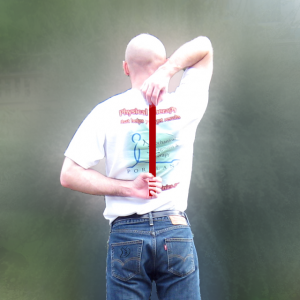“I was referred to Nick by my orthopedic specialist because I was suffering extreme arthritic neck pain, which greatly limited my mobility and caused debilitating headaches.
My outcome after 4 visits…
– I know how to quickly get rid of my now, very rare, headaches
– My neck feels normal again. Range of motion is back and it’s moving without pain.
Thank you Nick! For creating such a warm and caring atmosphere. AND sharing your knowledge to help me get better. And the laughs!
Thank you Kari ! For your massages, tips and beautiful smiles.
I recommend your practice to all!”
Jennifer
More
NOW is the BEST time to get the treatment you need for your aches and pains and…
…get better before your insurance deductible or health savings account renews.
Get the most out of your dollars.
The end of the year is FAST approaching.
More quickly than we expect.
With an average number of visits of just 6-8, you can complete treatment before the end of the year and make the most of your health care benefits.
Don’t hesitate– call 503-244-6232
Schedule your evaluation today!
More
Nick came across this article about shoulder pain and MDT approach to treatment that we use at Nick Rinard Physical Therapy clinic. He thought it would be informational for our audience.
Excerpt
Case Report
Rapid resolution of chronic shoulder pain classified as derangement using the McKenzie method: a case series Maria Corazon Aytona1 , Karlene Dudley2 1 Southeastern Regional Medical Center, Lumberton, NC, USA, McKenzie Institute, NY, USA, 2 Southeastern Regional Medical Center, Lumberton, NC, USA The McKenzie method, also known as Mechanical Diagnosis and Therapy (MDT), is primarily recognized as an evaluation and treatment method for the spine. However, McKenzie suggested that this method could also be applied to the extremities. Derangement is an MDT classification defined as an anatomical disturbance in the normal resting position of the joint, and McKenzie proposed that repeated movements could be applied to reduce internal joint displacement and rapidly reduce derangement symptoms. However, the current literature on MDT application to shoulder disorders is limited. Here, we present a case series involving four patients with chronic shoulder pain from a duration of 2–18 months classified as derangement and treated using MDT principles. Each patient underwent mechanical assessment and was treated with repeated movements based on their directional preference. All patients demonstrated rapid and clinically significant improvement in baseline measures and the disabilities of the arm, shoulder, and hand (QuickDASH) scores from an average of 38% at initial evaluation to 5% at discharge within 3–5 visits. Our findings suggest that MDT may be an effective treatment approach for shoulder pain.
http://www.ncbi.nlm.nih.gov/pmc/articles/PMC3822320/pdf/jmt-21-04-207.pdf
More
‘R.I.C.E.’ Coined in 1978
‘R.I.C.E.’ (rest, ice, compression, elevation) was coined in 1978 by Dr. Gabe Mirkin. Since then, ice has been the standard treatment for injuries and sore muscles. The RICE guidelines have been used for decades, but it now appears that ice and rest may delay healing.
Scientific Articles Don’t Support Ice for Healing
 A study from The American Journal of Sports Medicine, June 2013 asked athletes to exercise intensely enough to develop muscle damage that caused extensive muscle soreness. It was found that icing delayed swelling, but did not quicken the healing process. A summary of 22 scientific articles found little to no evidence supporting that ice and compression facilitate healing over compression alone.
A study from The American Journal of Sports Medicine, June 2013 asked athletes to exercise intensely enough to develop muscle damage that caused extensive muscle soreness. It was found that icing delayed swelling, but did not quicken the healing process. A summary of 22 scientific articles found little to no evidence supporting that ice and compression facilitate healing over compression alone.
Inflammation
Inflammation is required for healing. Inflammation is a part of our immune system and is essential in the healing process. Inflammatory cells migrate to the injured tissue to start the healing process. Macrophages (inflammatory cells) release a hormone into injured tissues, which helps muscles and other injured tissues heal. Applying ice to reduce swelling can delay healing by preventing the body from releasing this hormone.
Icing can also prevent healing cells from entering the injured tissues by constricting blood-flow. It can take hours for the blood vessels to return to their size. Icing can also decrease strength, speed, endurance and coordination.
General Tips for Using Ice
If you’re going to ice, only apply ice for 10-15 minutes at a time. Utilize ice for the first day of injury. Seek medical attention from a mechanical physical therapist if the pain is severe or you cannot actively move a body part.
More
 A mistake that people often make is waiting too long to start physical therapy treatment for their aches and pains. This commonly occurs because you may be thinking, “this will go away on its own,” or, “it’s just normal for me to feel like this at my age.” I want to clear up some confusion on mechanical pain versus normal muscle soreness that does not require skilled therapy or treatment.
A mistake that people often make is waiting too long to start physical therapy treatment for their aches and pains. This commonly occurs because you may be thinking, “this will go away on its own,” or, “it’s just normal for me to feel like this at my age.” I want to clear up some confusion on mechanical pain versus normal muscle soreness that does not require skilled therapy or treatment.
Muscular Pain:
- Experienced after a sudden increase in activity or exercise.
- Running 6 miles when you typically only run 2 miles
- You increased the intensity or length of time to your typical workout
- Will be experienced 1-2 days after the increased activity has been performed and will typically begin to dissipate or be gone in 3-5 days after onset.
- Is typically vague pain or experienced in a general area. The pain will not be sharp or pin-point to a specific area.
- If you’re educated on what muscles perform which actions, the sore muscles will correlate with what activity you were performing.
- Does not have increased or decreased pain associated with positions.
Mechanical Pain:
- May have a sudden onset without explanation of occurrence (you woke up with pain for no apparent reason).
- Will typically have a loss in range of motion. For example: it may be difficult to stand up straight in the morning or after prolonged sitting or driving.
- Will have positions that will increase or decrease symptoms. For example: pain increases with sitting, pain is better while lying down.
If you’re experiencing mechanical pain the sooner you seek physical therapy treatment, the better! A good Physical Therapist can determine which exercises will reduce your symptoms and get you back to doing the activities that you love!
More
I recently had a follow up appointment with a patient of mine. “Sam” came to our clinic after having failed attempts of treatment from standard Physical Therapy and chiropractic care. His past physical therapist had given him generalized stretching with little to no benefit, and by the time I evaluated him, Sam admitted that, “(he) was not impressed with his therapy treatment.” He had heard about Nick Rinard Physical Therapy, and he was hoping to get the results he desired with us.
During his initial evaluation, Sam presented with limited, painful movements in several motions of the shoulder. The most painful motion was the motion of putting the arm behind him (like he was going to scratch in between his shoulder blades). Incidentally, this was also the motion which initially caused his pain three months ago.
 I had Sam passively stretch into the painful motion. This was not a random decision. It was a clinical decision based off of his baselines and has been clearly documented and researched by the works of Mark Laslett. As Sam repeated this movement, the pain dissipated and all of his baselines improved. Sam continued to perform this exercise until his next visit, at which, he reported 95% improvement.
I had Sam passively stretch into the painful motion. This was not a random decision. It was a clinical decision based off of his baselines and has been clearly documented and researched by the works of Mark Laslett. As Sam repeated this movement, the pain dissipated and all of his baselines improved. Sam continued to perform this exercise until his next visit, at which, he reported 95% improvement.
Sometimes the exercise required to fix the mechanical problem is counterintuitive (moving into the pain). A trained mechanical therapist is able to recognize these pain patterns and can make a clinical decision as to what exercise should be performed and interpret the results.
More



